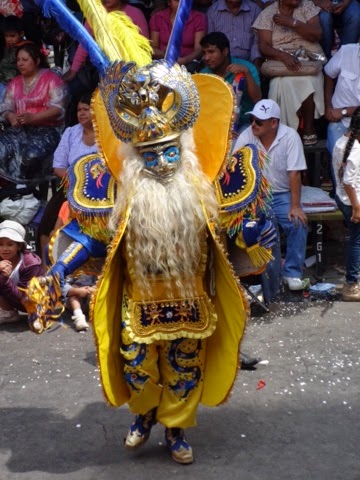Water
Really, the most important part of Carnaval celebrations in Cochabamba is getting people as wet as possible. For weeks leading up to Ash Wednesday, kids sit on street corners and squirt water guns at people walking by. Teenagers drive through the streets, armed with water balloons, throwing them at pedistrians. It starts out slowly. Towards the end of January, I was only getting hit once a week. But in Carnaval weekend, you can't escape it. Kids are armed and ready on every block. Every corner store and street stall starts selling cans of foam, another important squirting-people tool.
Water fights are also big. We had two at Madre de Dios. The girls and I rounded up all the weapons we could find (balloons, plastic bottles, buckets), filled them in the rain water tank, and ran around the outdoor court getting each other as soaked as possible. On Tuesday, we loaded up buckets with water balloons and roamed the streets, looking for other kids to do battle with, until we arrived at a boys home that's part of our organization. Unfortunately, the boys had misbehaved earlier that day and weren't allowed to go out, but they still very impressively managed to throw a dozen water balloons over their gate and all the way down the block to get us.
And it's not just kids who get in on the action. I went to the 27th birthday party of a friend's friend the Sunday of Carnaval, and the first thing he did when we arrived was push us into a pool. A few days earlier, I'd gone to a barbeque full of college graduates where, even though the weather was about 65 degrees and cloudy, all of the guys insisted on filling up an inflatable kiddy pool and daring each other to get in.
Fun Scale: 4/10. The water fights with the girls were awesome, but getting hit in the butt with water balloons while walking to work is not. Especially because Februrary is awfully rainy and chilly to begin with.
Parades
What Cochabamba does have on Carnaval weekend is a kids' parade, which the girls and everyone who works at Madre de Dios (including me) got to march in this year. The morning was a little chaotic, as all of the girls and adults scrambled to find costumes out of the mountain of outfit pieces someone had lent us, and then as we got 65 people downtown using just one van. The last group of girls arrived well after the parade had started, just in time for us to organize ourselves and hop into our position as #134 in line.
We sorted ourselves into three groups: witches, Chakarera dancers (the ones with the big swirly Spanish skirts), and little girls (who, because they didn't fit into the other costumes, were wearing whatever we could find for them). Sure, other groups had floats or music or organized dances, but we made up for our rag-tag-ness with lots of spirit. The dancers swirled their skirts and danced to the songs the group in front of us was playing. The witches ran around trying to scare the kids in the audience who were (of course) squirting us with water guns and cans of foam.
The next week, I went to the adult Carnaval parade in Cochabamba, and it was great. The first part of the parade is made up of just soldiers. All young men in Bolivia have to do a year of military service (on the weekends or after school), and each unit comes up with their own theme to march in the parade. There were the invisible men, wearing shirts over their heads, with glasses and hats suspended by wires above them. Another group made a huge fish float entirely out of recycled bags of juice. Lots of them were popular characters from TV or movies: One group had a lone Batman followed by 100 Jokers...another group made a huge Gru float and danced on it dressed as Minions...a few groups went as the Avengers (making a suprising amount of Captain Americas for an army that doesn't like the US all that much)...there was also a group of just Olafs from Frozen.
After the soliders came hundreds of dancing groups. The post was too big to upload all at once, so I'll publish the rest of the pictures soon!






